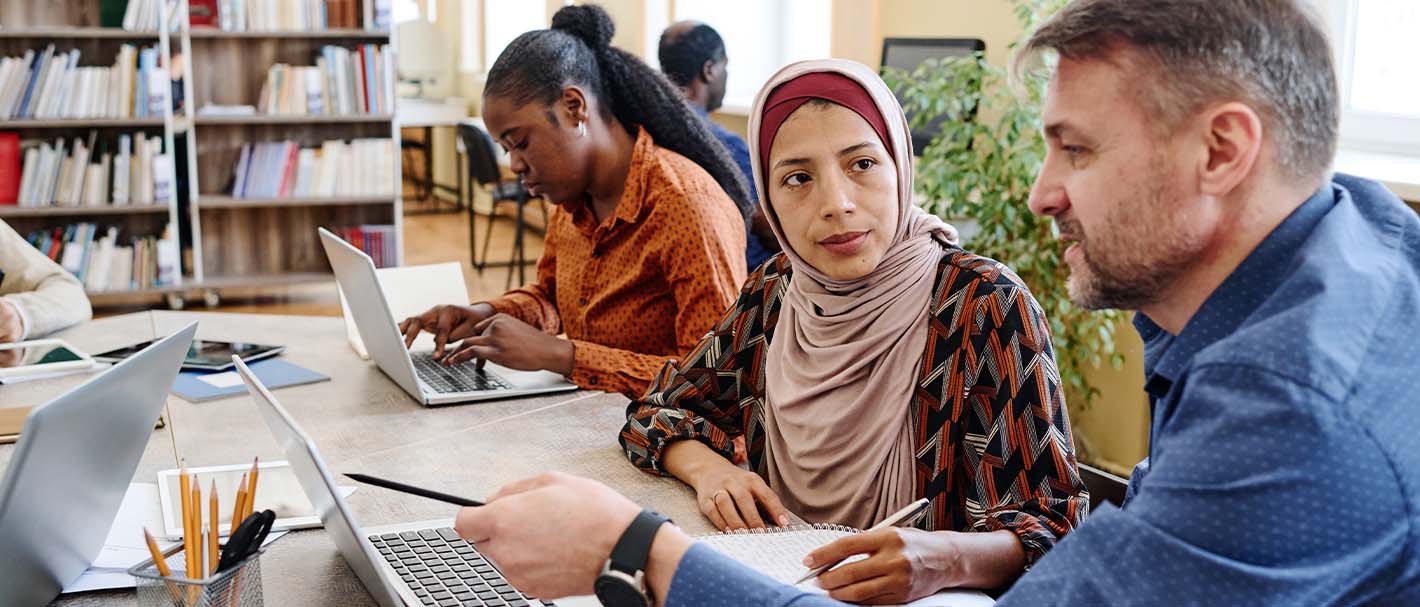19. February 2025 | Interviews
ELMI Policy Talk: Immigrant integration services in Germany, Sweden and Finland


Hanna Pesola, PhD, is a chief researcher and research leader at the VATT Institute for Economic Research.
ELMI is the Network of European Labour Market Research Institutes, which was founded in October 2022. The network’s goal is to deepen multidisciplinary research-cooperation, exchange best practice on data-management and -access, and strengthen dialogue between scientists and practitioners. Through the “ELMI Policy Talk” format, researchers can regularly present their findings to an audience from science, politics and practice.
The 5th ELMI Policy Talk focused on immigrant integration services in Germany, Sweden, and Finland was hosted virtually by the Finish Institute for Economic Research (VATT) in Helsinki. At the event, three speakers, who are all researchers at member institutions and experts in their field, presented findings on their country’s immigration integration services.
After a warm welcome and brief introduction from Hanna Pesola, PhD, chief researcher and research leader at the VATT, Regina Konle-Seidl, senior research fellow at the IAB, opened with her presentation on “Immigration Integration Services in Germany”.
Regina Konle-Seidl (Germany): “Labour market integration in terms of employment rate has improved despite high level inflow of refugees since 2015.”

Regina Konle-Seidl is a senior research fellow at the IAB.
Compared to other countries, Germany’s integration strategy emphasises early access to support for asylum seekers, persons with residence permits and tolerated individuals whose obligation to leave has been temporarily suspended, and those with residence permits.
Given that language skills are a key obstacle to employability, Germany adopts a “Language skills first” approach where mandatory integration courses provided language instruction with civic orientation provided by the Federal Office for Migration and Refugees (BAMF). In 2024, this was supplemented by the “Job Turbo” that combined early job search with language training.
Evidence indicates that these policies are effective. Evaluation of the formal integration courses are not only effective in language acquisition, but also employment, relative to ad-hoc language programmes. Further, Active Labour Market Programmes, such as dual apprenticeships, vocational training, and hiring subsidies, have also shown positive outcomes in advancing labour market integration. However, evaluations indicate that activation programmes were less effective.
Refugee specific measures, like those that target youth or combine language and vocational training have shown varying levels of success. Evaluations suggest that measures involving employer participation, such as hiring subsidies and on-the-job training, strongly support sustainable employment outcomes. However, these measures can be resource-intensive and difficult to scale.
Challenges include a large gender gap in employment after migration and the need to balance rapid and sustainable integration strategies. For the 2015/2016 cohort of refugees, there is a gradual improvement in the quality of employment with 66 percent holding permanent contracts and 90 percent in employment subject to social security contributions. At the same time, 41 percent are still employed below their educational level six years after arrival and median wages remain close to the low-wage threshold.
Despite the challenges, there are positive signs of labour market integration in terms of language acquisition, employment rates and self-sufficiency. These positive signs are partially the result of improvements made to institutions that provide support as well as favourable labour market conditions.
Anders Forslund (Sweden): “Some labour market programmes have had positive impacts for the target group.”
Following from this, Dr Anders Forslund, Professor Emeritus at the Institute for Evaluation of Labour Market and Education Policy elaborated in more detail on Sweden’s approach to integrating refugees into the labour market in his presentation “ALMPs for refugees and their relatives”.
The presentation mostly focused on Active Labour Market Programmes (ALMP) to help refugees and their relatives do better in the labour market. Sweden provides a comprehensive 2-year introductory programme for immigrants, incorporating language training, vocational education, and job search assistance. In the past, the Introductory Programme was provided by the municipalities, but were transferred to the Public Employment Service (PES) in 2010.
The transition has likely improved labour market outcomes, particularly for women, by modifying financial incentives. At the same time, one challenge for evaluators is that most programmes are universally provided, making it difficult to find an appropriate control group with which the participants can be compared.
Vocational training offered by PES has shown success, especially when paired with language training and practical job experience in intensive programmes, as demonstrated through collaboration with Gothenburg municipality. Subsidised jobs have also proven effective, provided they occur in genuine workplaces offering real employment opportunities. Positive outcomes are also linked to programmes emphasising real employment opportunities, such as subsidised jobs and apprenticeships. Intensive caseworker support and combined language-vocational training have also proven effective.
In contrast, activation policies requiring social assistance recipients to participate in municipal programmes have shown little positive impact. Further, a persistent gender gap remains, with men benefiting more than women from most programmes. These results are consistent with the German case.
Kari Hämäläinen (Finland): “The Integration Plan increased cumulative earnings of immigrant adults, improved immigrants’ children’s educational attainment outcomes, and reduced social benefit receipt.”

Kari Hämäläinen, PhD, is a chief researcher at the Finish Institute for Economic Research VATT
Kari Hämäläinen, PhD, chief researcher at the Finish Institute for Economic Research VATT, gave the final presentation, titled “Immigrant integration services in Finland”. He provided an overview of Finland’s approach to integrating immigrants, focusing on the Integration Plan and related training programmes.
Compared to other EU countries, Finland shows higher employment rates among prime-age immigrants, men and women. One reason is that Finland employs a highly structured approach, starting with a personalised Integration Plan for newcomers, which outlines tailored support monitored for at least a year. Integration training lasts up to two years and includes 2,100 hours of language and labour market preparation based on a national curriculum.
The personalised Integration Plan achieved good labour market outcomes, with clear evidence supporting its effectiveness. Evidence from reforms introduced in 1999 shows significant long-term benefits. These include a 47 percent increase in cumulative earnings and a 13 percent reduction in social benefit reliance for affected immigrants over a decade. Additionally, intergenerational effects have also been observed, with improved grades, extended educational attainment, and increased earnings for children of immigrants subject to the policy.
A randomised experiment conducted from 2016 to 2019, highlighted the success of fast-track employment programmes. Participants in the treatment group experienced 18 percent higher cumulative earnings and a 5 percent increase in employment rates compared to the control group. Key success factors included personalised services, language skill development, and fostering connections between immigrants and employers.
However, challenges remain despite these positive outcomes. Notably, while immigrants make up just 10 percent of Finland’s population, their numbers have doubled over the past decade, which may limit the ability to provide effective integration policies in the future. Further, until recently, contact between integration services and refugee women was limited. This will change in 2025 when the Integration Plan will be provided to individuals who receive a home-care allowance, most of whom are women.
Conclusion
Despite variations, Germany, Sweden, and Finland share common elements in their immigrant integration strategies, including a strong emphasis on language training and Active Labour Market Programmes. In all three countries, integration of female refugees and immigrants remain a persistent challenge, albeit for different reasons. And in Germany and Sweden, activation programmes were found to be not very effective.
Bild: Pressmaster/stock.adobe.com
DOI: 10.48720/IAB.FOO.20250219.02
Latner, Jonathan (2025): ELMI Policy Talk: Immigrant integration services in Germany, Sweden and Finland, In: IAB-Forum 19th of February 2025, https://iab-forum.de/en/elmi-policy-talk-immigrant-integration-services-in-germany-sweden-and-finland/, Retrieved: 26th of December 2025
Diese Publikation ist unter folgender Creative-Commons-Lizenz veröffentlicht: Namensnennung – Weitergabe unter gleichen Bedingungen 4.0 International (CC BY-SA 4.0): https://creativecommons.org/licenses/by-sa/4.0/deed.de
Authors:
- Jonathan Latner

 Dr Jonathan Latner is a as a researcher in the Center for Empirical Methods (KEM) at IAB since 2023.
Dr Jonathan Latner is a as a researcher in the Center for Empirical Methods (KEM) at IAB since 2023.